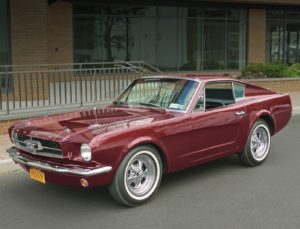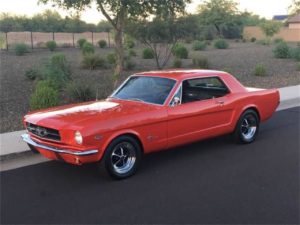
Automobile styling changed radically during the twenty years that followed WWII’s end. Cars were big rolling boxes in 1945. By 1965, they had gotten smaller, sleeker, and faster. And one design in particular proved itself to be timeless, selling in huge numbers over thirty years after its introduction.
The Ford Mustang was the result of an in-house design contest sponsored by division manager Lee Iacoca. The winning design was the work of David Ash and John Oros.
The Mustang itself was released against a wave of opposition within Ford’s ranks. Squabbling and in-fighting almost doomed what is arguably the most successful model of car ever released.
In 1961, engineers Herb Misch and Roy Lunn designed a two seat mid-engine convertible that weighed a mere 1500 pounds and got 30 miles to the gallon while posting a respectable 10 second zero-to-sixty time.
Sports car fans both outside and inside Ford’s organization eagerly licked their chops at the idea of such a European-thinking design rolling out of Ford’s factories. But Lee Iaccoca saw a money pit instead.

But he did see the need of a compact, sporty, albeit FOUR seat car. So he took the design of Ash and Oros and built it on existing tooling. The Mustang that was released had a reworked Falcon frame. The suspension and drivetrain came from altered parts from both the Falcon and Fairlane. But there’s no doubt that NOBODY would mix up the small, clean, slick style of the Mustang with its ancestors.
Some high-ranking powers within Ford opposed the car. But Iaccoca prevailed. And 22,000 models were sold the day it was released in 1964 (but it was a 1965 model). Within two years, a million Mustangs were on the road. The silence of the opposers was deafening.
Soon, Mustangs were seen all over television, too, and not just in Ford commercials. For instance, what Baby Boomer doesn’t remember the “Like father, like son” antismoking commercial? The car also frequently showed up in movies and TV series of the decade.
In 1965, Ford cut a deal with former Formula One driver-turned-designer Carrol Shelby to produce the Shelby Mustang, a heavily customized, expensive vehicle that was a smash hit. The engine was a modified Windsor 289, and a few models had trunk-mounted batteries. They are highly prized collectibles today.
Shelby continued customizing Mustangs until the 1970 model year. Ford and Shelby cut a deal with Hertz to produce a gold-striped Shelby that customers could rent, and that would be sold to the public after retirement. They too were a success for all involved. The only problem was that a few enterprising customers would rent the car for a weekend and spend the time in their garages swapping the Shelby motor for a standard 289. So if you get a chance to buy one, caveat emptor.
Mustangs endured bad design changes, continuing to sell well even during the Mustang II era, when purists say the car hit its artistic nadir. But sales slowed through the 80’s, and there was talk of redesigning the car as a front-wheel drive. The Mustang faithful wrote letters of protest in droves, and the redesign became the Ford Probe instead.
Today’s Mustang looks a lot like its 60’s ancestors. Even Carrol Shelby is back to customizing them, and Hertz is also renting their own models! So, in the automotive sense, in the case of a great design, what goes around sometimes does indeed come around.